Fibromyalgia is a chronic, long-term condition that causes pain throughout the body. In addition to fibromyalgia, it can also cause other symptoms, including extreme tiredness, headaches, muscle aches and stiffness, mood swings, anxiety, brain fog (such as difficulty concentrating on tasks and remembering things), and difficulty sleeping. A lot of research is being done about the exact cause(s) of fibromyalgia pain, but so far, it’s still not fully understood.
However, researchers believe it is related to an imbalance of certain chemicals in the brain and the way the brain and central nervous system process pain messages. Fibromyalgia can occur as a result of physical or emotional trauma, such as an accident, injury, death, relationship breakup, surgical procedure, or difficult childbirth.
The disease is difficult to diagnose, and as of now, there is no definitive test for this condition. Therefore, it is also difficult to know how many people are infected, but it is estimated that about 1 in 20 people. It is more common in women and tends to develop between the ages of 30 and 50.
Currently, there is no cure for fibromyalgia, although some people find taking pain relievers and antidepressants helpful, along with talking therapies such as cognitive behavioral therapy (CBT). However, there are lifestyle modifications that can help you manage symptoms, so here are the top ten suggestions for treating fibromyalgia…
1. Manage Your Energy Levels
 Since there is no definitive test or treatment for fibromyalgia, having this condition can be annoying, especially if those around you are suspicious of your condition. Constant pain, especially in tender points associated with fibromyalgia (the back of the head, above the shoulders, upper chest, outside the elbows, hips, and knees), along with lack of sleep, fatigue, and a bad mood can be exhausting.
Since there is no definitive test or treatment for fibromyalgia, having this condition can be annoying, especially if those around you are suspicious of your condition. Constant pain, especially in tender points associated with fibromyalgia (the back of the head, above the shoulders, upper chest, outside the elbows, hips, and knees), along with lack of sleep, fatigue, and a bad mood can be exhausting.
So number one on our list of fibromyalgia treatments is the importance of knowing that your symptoms are real. Find your GP and specialist doctors and believe that you will find a treatment plan that works for you. It is essential that you take time for yourself and practice self-care.
This could be a time to stop every night to rest and do something relaxing that you enjoy, such as reading or watching your favorite shows. Or it could mean spending time with people who understand, lift your spirits, and bring peace and positivity into your life. Taking breaks is also important, so it may be helpful to talk to your manager or human resources department about ways you can incorporate breaks into your workday. Flexible work and working days from home can be beneficial.
Do what you have to do every day to be kind to yourself.
2. Take Regular, Moderate Exercise
 When you feel physical pain and fatigue, the last thing you might want to do is exercise. But studies consistently show that regular exercise benefits people with fibromyalgia. But it’s important not to overdo it and find the right balance instead. Light aerobic exercise has been shown to improve the quality of life for people with fibromyalgia.
When you feel physical pain and fatigue, the last thing you might want to do is exercise. But studies consistently show that regular exercise benefits people with fibromyalgia. But it’s important not to overdo it and find the right balance instead. Light aerobic exercise has been shown to improve the quality of life for people with fibromyalgia.
A study of more than 400 women with the condition found that “light physical exercise” was associated with less physical pain and fatigue and an overall improvement in symptoms. Light exercise includes gentle walking and swimming.
You can start slowly, over a short period of time or distance, and build your flexibility over time. Pool exercise classes are believed to be the most beneficial because the water supports the body, making each movement work more forcefully for the muscles. Intense cardio exercises, such as running or a HIIT class, can be too strenuous for a person with fibromyalgia, but resistance exercises can be beneficial.
Resistance exercises, or strength training, can include bodyweight resistance exercises such as squats and lunges, as well as adding light, manageable weights. Studies show that such exercises can lead to “reduced pain, fatigue, number of weaknesses, depression, and anxiety, while increasing functional capacity and quality of life.”
3. Take Steps to Achieve Enough Good Quality Sleep
 Fibromyalgia is a condition known to disrupt sleep patterns, resulting in poor sleep quality and disturbed sleep. Chronic lack of sleep leads to fatigue, irritability, poor concentration and mood swings, which can also be caused by this condition.
Fibromyalgia is a condition known to disrupt sleep patterns, resulting in poor sleep quality and disturbed sleep. Chronic lack of sleep leads to fatigue, irritability, poor concentration and mood swings, which can also be caused by this condition.
The pain associated with fibromyalgia can also mean you can’t sleep, and not getting enough sleep can exacerbate your pain response — a vicious cycle. In addition, fibromyalgia can also lower your pain threshold, which means you feel more intense pain. Therefore, it is very important that you do everything in your power to get enough quality, restful sleep. Achieving “good sleep habits” can mean improving the quality of your sleep.
This means having a relaxing and relaxing nighttime routine that signals to your brain that it is time to go to bed and relax. The first step is to go to bed and wake up at the same time every day, even on weekends. This helps set your body clock into a routine when you feel tired and wake up. Also, be sure to avoid anything very exciting in the hour before bed. This includes avoiding caffeine, alcohol, nicotine, large meals, strenuous exercise, or watching stimulant television. It also means avoiding using your smartphone, tablet or laptop because of the blue light from screens that tricks your brain into thinking it’s daytime.



 Sugar harms your skin through a natural process known as glycation. Advanced glycation end products, or AGEs, are dangerous free radicals that are created when the sugar in your blood binds to proteins (AGEs). As AGEs accumulate, they destroy the proteins that surround them. Collagen and elastin, which form the foundation of your skin, are the proteins that are most susceptible to harm. These proteins maintain skin’s firmness and elasticity and are what give a healthy, youthful complexion its traits of plumpness and bouncy skin. Your collagen and elastin become stiff, dry, and brittle as a result of AGEs, losing their elasticity.
Sugar harms your skin through a natural process known as glycation. Advanced glycation end products, or AGEs, are dangerous free radicals that are created when the sugar in your blood binds to proteins (AGEs). As AGEs accumulate, they destroy the proteins that surround them. Collagen and elastin, which form the foundation of your skin, are the proteins that are most susceptible to harm. These proteins maintain skin’s firmness and elasticity and are what give a healthy, youthful complexion its traits of plumpness and bouncy skin. Your collagen and elastin become stiff, dry, and brittle as a result of AGEs, losing their elasticity. You’ve probably heard that eating processed meats increases your chance of developing chronic illnesses including diabetes, cancer, heart disease, stroke, and early death. But these delicious delights also hasten skin aging. This is because meats with a high salt and nitrate content, such as salami, pepperoni, and sausage, age the skin and cause wrinkles. The addition of nitrates and excessive sodium to processed meats amplifies the damage. Both cause the AGEs (advanced glycation end products), which worsen wrinkles and dullness by increasing the breakdown of collagen and elastin.
You’ve probably heard that eating processed meats increases your chance of developing chronic illnesses including diabetes, cancer, heart disease, stroke, and early death. But these delicious delights also hasten skin aging. This is because meats with a high salt and nitrate content, such as salami, pepperoni, and sausage, age the skin and cause wrinkles. The addition of nitrates and excessive sodium to processed meats amplifies the damage. Both cause the AGEs (advanced glycation end products), which worsen wrinkles and dullness by increasing the breakdown of collagen and elastin. Alcohol, the ultimate dehydrator, also depletes our bodies of vitamins A, B, and C, which is essential for healthy skin and overall wellbeing. Excessive alcohol use depletes critical fatty acids, magnesium, and zinc, all of which are necessary to delay the development of premature aging. It’s not surprising that drinking alcohol is detrimental for your appearance when you consider the extra side effect of poor sleep hygiene.
Alcohol, the ultimate dehydrator, also depletes our bodies of vitamins A, B, and C, which is essential for healthy skin and overall wellbeing. Excessive alcohol use depletes critical fatty acids, magnesium, and zinc, all of which are necessary to delay the development of premature aging. It’s not surprising that drinking alcohol is detrimental for your appearance when you consider the extra side effect of poor sleep hygiene. A single frozen meal can have half the sodium of a normal daily intake. When you consume too much salt, your kidneys become flooded and you drink more than usual. Any surplus water will migrate to your hands and face, which have less salt in them than other parts of your body. That’s what gives you a puffy appearance. Oxidative stress and inflammation—both of which are linked to dehydration—as well as ultra-processed meals are common causes of telomere atrophy. The imbalance of free radicals and antioxidants brought on by oxidative stress can have a number of effects, including weakened immunity and aging skin.
A single frozen meal can have half the sodium of a normal daily intake. When you consume too much salt, your kidneys become flooded and you drink more than usual. Any surplus water will migrate to your hands and face, which have less salt in them than other parts of your body. That’s what gives you a puffy appearance. Oxidative stress and inflammation—both of which are linked to dehydration—as well as ultra-processed meals are common causes of telomere atrophy. The imbalance of free radicals and antioxidants brought on by oxidative stress can have a number of effects, including weakened immunity and aging skin. If you want to live a long, healthy life, stay away from the salt shaker. While some salt consumption is acceptable, the majority of individuals consume far too much. Consuming excessive amounts of sodium raises your risk for heart disease, stroke, and stomach cancer. Excessive salt consumption can also exacerbate the aging process at the cellular level.
If you want to live a long, healthy life, stay away from the salt shaker. While some salt consumption is acceptable, the majority of individuals consume far too much. Consuming excessive amounts of sodium raises your risk for heart disease, stroke, and stomach cancer. Excessive salt consumption can also exacerbate the aging process at the cellular level. Red meat produces free radicals. Free radicals are molecules that only have one electron instead of two, making them unstable and more likely to snag electrons from other molecules, which will then turn them into unstable cells that will snag electrons from other cells, etc. Free radicals interfere with the skin’s capacity to produce collagen and defend itself. Consume a lot of antioxidant-rich fruits and vegetables together with lean meats like chicken and turkey.
Red meat produces free radicals. Free radicals are molecules that only have one electron instead of two, making them unstable and more likely to snag electrons from other molecules, which will then turn them into unstable cells that will snag electrons from other cells, etc. Free radicals interfere with the skin’s capacity to produce collagen and defend itself. Consume a lot of antioxidant-rich fruits and vegetables together with lean meats like chicken and turkey. Caffeine, which is present in energy drinks, sodas, and coffee, dehydrates the body. Lack of hydration has significant negative effects on the skin, increasing the likelihood of wrinkles, fine lines, age spots, and dullness. Additionally, it disrupts your sleep, which is a terrific way to quickly age 10 years. If you must have your morning coffee, be careful to hydrate yourself by drinking lots of water.
Caffeine, which is present in energy drinks, sodas, and coffee, dehydrates the body. Lack of hydration has significant negative effects on the skin, increasing the likelihood of wrinkles, fine lines, age spots, and dullness. Additionally, it disrupts your sleep, which is a terrific way to quickly age 10 years. If you must have your morning coffee, be careful to hydrate yourself by drinking lots of water.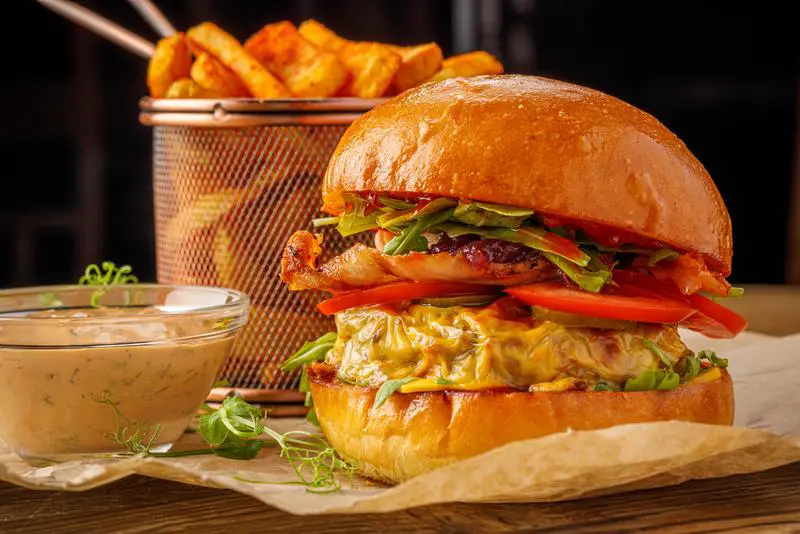 Trans fats may be detrimental for your skin in addition to raising LDL (bad) cholesterol and increasing the risk of heart disease. The majority of trans fats are produced by adding hydrogen to liquid vegetable oils in order to solidify them. Inflammation is encouraged by trans fats. Inflammation is also harmful to collagen. Never believe a label that claims “0 g trans fat,” as it may still contain as little as 0.5 g of synthetic fat. Be sure to stay away from items that have partially hydrogenated oil listed as an ingredient.
Trans fats may be detrimental for your skin in addition to raising LDL (bad) cholesterol and increasing the risk of heart disease. The majority of trans fats are produced by adding hydrogen to liquid vegetable oils in order to solidify them. Inflammation is encouraged by trans fats. Inflammation is also harmful to collagen. Never believe a label that claims “0 g trans fat,” as it may still contain as little as 0.5 g of synthetic fat. Be sure to stay away from items that have partially hydrogenated oil listed as an ingredient.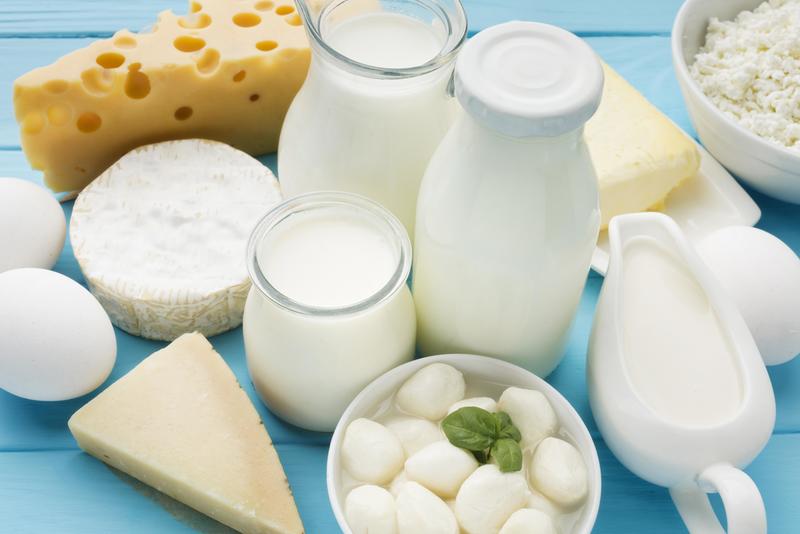 Dairy products do include calcium, which is important for bone health and muscle function, but they also have a tendency to worsen inflammation, which raises the risk of oxidative stress, one of the factors that contribute to premature aging. Dairy contains a lot of lactose, a milk sugar that can enhance the production of AGEs and damage collagen. Try to get your calcium from other sources instead, including milk substitutes or a diet high in green leafy vegetables. It’s acceptable to occasionally consume a small amount of low-sugar Greek yogurt, but make sure to read the label and compare products to choose the one with the least amount of sugar.
Dairy products do include calcium, which is important for bone health and muscle function, but they also have a tendency to worsen inflammation, which raises the risk of oxidative stress, one of the factors that contribute to premature aging. Dairy contains a lot of lactose, a milk sugar that can enhance the production of AGEs and damage collagen. Try to get your calcium from other sources instead, including milk substitutes or a diet high in green leafy vegetables. It’s acceptable to occasionally consume a small amount of low-sugar Greek yogurt, but make sure to read the label and compare products to choose the one with the least amount of sugar.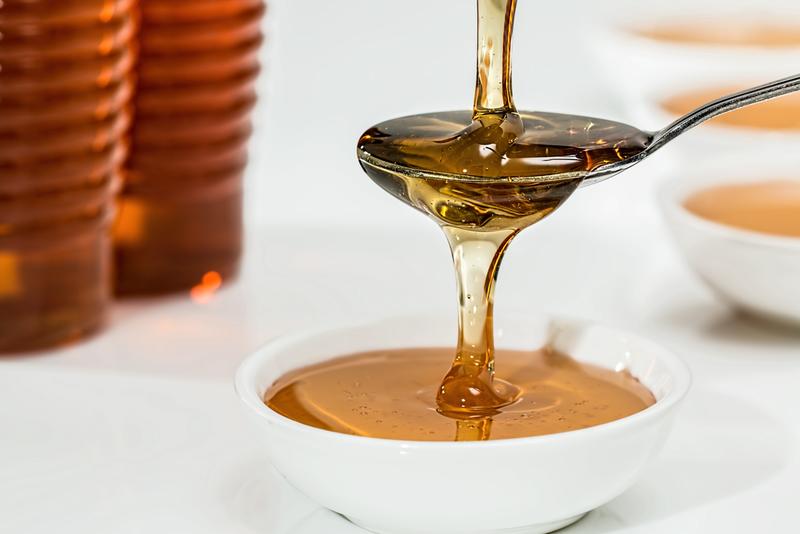 Foods made from corn, such as corn cereals and corn chips, have a significant effect on blood sugar levels, which can lead to an increase in the body’s AGEs and speed aging. According to research, the fructose in high-fructose corn syrup (HFCS) results in 10 times more AGE production in the body than glucose. This means that the HFCS you ingest every day in sweetened beverages and the majority of other processed foods (even salad dressings and ketchup) causes your body to age more quickly. Another significant problem with corn foods and corn oils is the excessive amount of omega-6 fatty acids they provide to your diet. This imbalance between omega-3 and omega-6 fatty acids results in inflammation and oxidation in your body.
Foods made from corn, such as corn cereals and corn chips, have a significant effect on blood sugar levels, which can lead to an increase in the body’s AGEs and speed aging. According to research, the fructose in high-fructose corn syrup (HFCS) results in 10 times more AGE production in the body than glucose. This means that the HFCS you ingest every day in sweetened beverages and the majority of other processed foods (even salad dressings and ketchup) causes your body to age more quickly. Another significant problem with corn foods and corn oils is the excessive amount of omega-6 fatty acids they provide to your diet. This imbalance between omega-3 and omega-6 fatty acids results in inflammation and oxidation in your body.







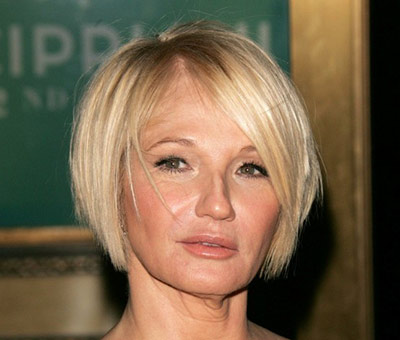



 We have delved into the male psyche to determine several aspects that make men consider short-haired women attractive.
We have delved into the male psyche to determine several aspects that make men consider short-haired women attractive. Short hair styles stand out from the rest, so men tend to notice them. According to the information we have been able to gather, many men who prefer women with short hair, claim that this type of hairstyle is not as common as long hair and that makes it special. If a woman can wear a pixie haircut, it can be irresistible and undoubtedly draw attention.
Short hair styles stand out from the rest, so men tend to notice them. According to the information we have been able to gather, many men who prefer women with short hair, claim that this type of hairstyle is not as common as long hair and that makes it special. If a woman can wear a pixie haircut, it can be irresistible and undoubtedly draw attention. You may have noticed that in many fashion shows the models wear their hair up and try to give maximum light to their face. This is because hair can be distracting and hide female features. Men seem to agree with this idea, they think that the face and neck are very attractive attributes for them and that short hair makes feminine beauty shine. Phrases like the following are what we have been told: “I don’t always find it attractive, but it makes the cheekbones and facial structure look pretty good. If you look closely at the face to determine the attractiveness, this may be a reason” “I think a big factor is how the neck and jaw shape stand out.
You may have noticed that in many fashion shows the models wear their hair up and try to give maximum light to their face. This is because hair can be distracting and hide female features. Men seem to agree with this idea, they think that the face and neck are very attractive attributes for them and that short hair makes feminine beauty shine. Phrases like the following are what we have been told: “I don’t always find it attractive, but it makes the cheekbones and facial structure look pretty good. If you look closely at the face to determine the attractiveness, this may be a reason” “I think a big factor is how the neck and jaw shape stand out. Many famously imposing women have worn pixie cuts, which creates a favorable association in the male mind. When asked if they like women with short hair, many men make an example of celebrities, which is favorable for other women to know who to draw inspiration from.
Many famously imposing women have worn pixie cuts, which creates a favorable association in the male mind. When asked if they like women with short hair, many men make an example of celebrities, which is favorable for other women to know who to draw inspiration from. Think about how long it takes to style long hair. It can be a real struggle of blow dryer, iron and curling iron, added to the price of styling products, which men consider exorbitant. Men hate it when women take too long to get ready. Conclusion: short hair is good for everyone.
Think about how long it takes to style long hair. It can be a real struggle of blow dryer, iron and curling iron, added to the price of styling products, which men consider exorbitant. Men hate it when women take too long to get ready. Conclusion: short hair is good for everyone.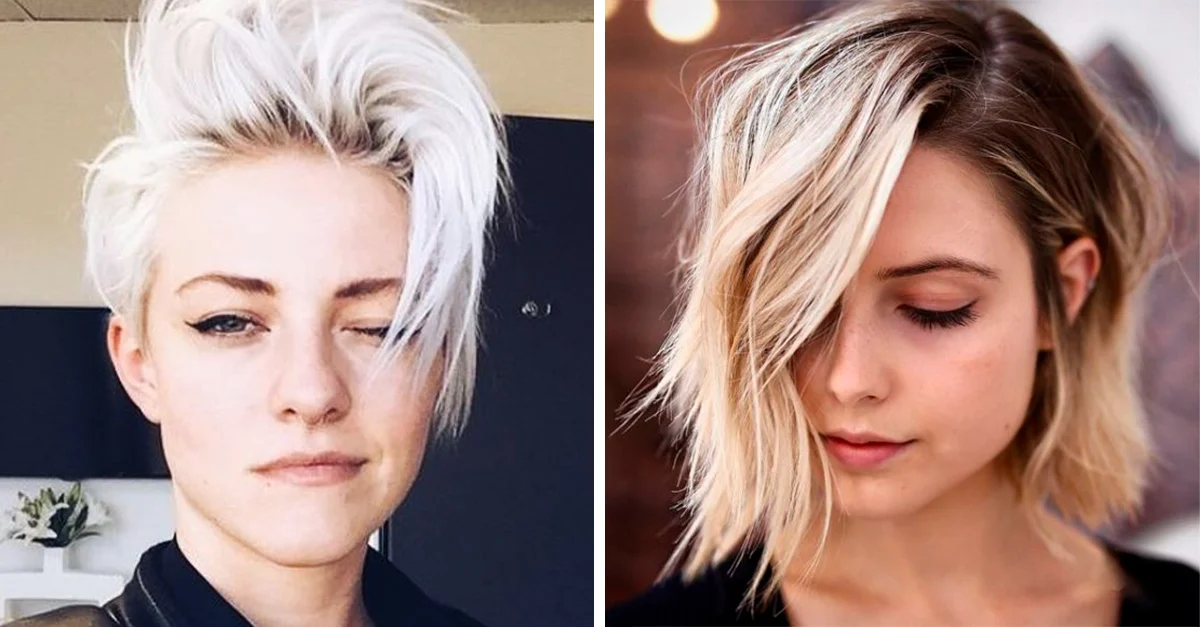 Not every woman is willing to experiment with short hair. Changing your look is always a risk, as we don’t always get the expected result and once we cut it, there’s no going back! It takes courage and, more importantly, confidence. Men are attracted to women with high self-esteem and short hair is a sign of that.
Not every woman is willing to experiment with short hair. Changing your look is always a risk, as we don’t always get the expected result and once we cut it, there’s no going back! It takes courage and, more importantly, confidence. Men are attracted to women with high self-esteem and short hair is a sign of that. Interestingly, men claim that a big advantage they like about short hair is when it comes to cuddling. They don’t like their partner’s hair getting in their mouth and eye. Besides, they also prefer not to find hair scattered in the shower, on the sheets, on the clothes, you can find hair everywhere, as far as you can imagine. It’s very practical!
Interestingly, men claim that a big advantage they like about short hair is when it comes to cuddling. They don’t like their partner’s hair getting in their mouth and eye. Besides, they also prefer not to find hair scattered in the shower, on the sheets, on the clothes, you can find hair everywhere, as far as you can imagine. It’s very practical! Last but not least, a short hairstyle does not happen by accident. If a woman bothers to choose a good haircut and keep it, it means she takes good care of herself. This is very important for men, as it shows that a woman is interested in taking care of her appearance. Do you prefer long or short hair in women? And for women: have you noticed a difference in men’s attention based on the length of your hair?
Last but not least, a short hairstyle does not happen by accident. If a woman bothers to choose a good haircut and keep it, it means she takes good care of herself. This is very important for men, as it shows that a woman is interested in taking care of her appearance. Do you prefer long or short hair in women? And for women: have you noticed a difference in men’s attention based on the length of your hair?
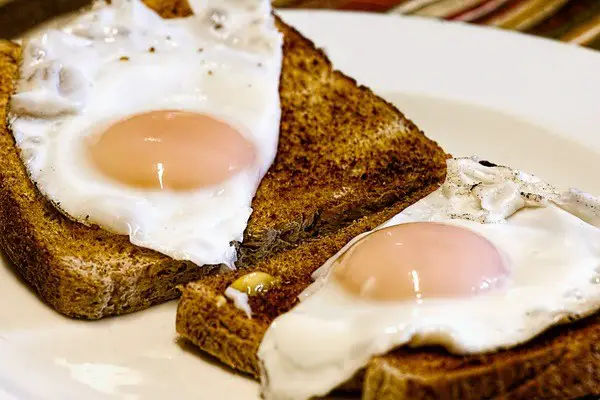 Eggs top our list of hair-healthy foods because they contain a lot of protein and biotin, as well as other nutrients like zinc and selenium. Hair follicles are mostly made of protein, and not enough protein in the diet is known to cause hair loss. Biotin is an essential nutrient for the production of a particular kind of protein called keratin. If you have a biotin deficiency, consuming more may help improve hair growth. Many supplements that purport to improve hair quality contain biotin for this reason.
Eggs top our list of hair-healthy foods because they contain a lot of protein and biotin, as well as other nutrients like zinc and selenium. Hair follicles are mostly made of protein, and not enough protein in the diet is known to cause hair loss. Biotin is an essential nutrient for the production of a particular kind of protein called keratin. If you have a biotin deficiency, consuming more may help improve hair growth. Many supplements that purport to improve hair quality contain biotin for this reason. Berries are a fantastic addition to your diet because they contain certain compounds and vitamins that promote hair growth. One of the biggest is vitamin C, which has strong antioxidant properties. Antioxidants help to protect hair follicles from being damaged by free radicals, which exist naturally in the body and are linked to aging. Our bodies also use vitamin C to produce collagen, a protein necessary to prevent hair from becoming brittle and breaking. And finally, vitamin C helps the body absorb iron and prevent anemia, which has also been linked to hair loss.
Berries are a fantastic addition to your diet because they contain certain compounds and vitamins that promote hair growth. One of the biggest is vitamin C, which has strong antioxidant properties. Antioxidants help to protect hair follicles from being damaged by free radicals, which exist naturally in the body and are linked to aging. Our bodies also use vitamin C to produce collagen, a protein necessary to prevent hair from becoming brittle and breaking. And finally, vitamin C helps the body absorb iron and prevent anemia, which has also been linked to hair loss.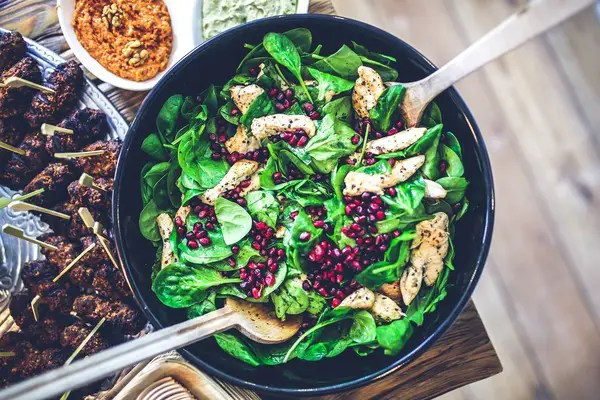 Spinach is a great all-around source for nutrients like folate, iron, and vitamins A and C. Each of these has a role to play in healthy hair growth. Vitamin A especially helps the skin glands produce sebum, an oily substance that moisturizes the scalp and in turn, keeps hair healthy. Iron is great for helping red blood cells carry oxygen through the body to aid growth and repair. One cup of spinach nets you 54% of your recommended daily vitamin A, plus 4% of RDA for iron for women and 10% of RDA for men.
Spinach is a great all-around source for nutrients like folate, iron, and vitamins A and C. Each of these has a role to play in healthy hair growth. Vitamin A especially helps the skin glands produce sebum, an oily substance that moisturizes the scalp and in turn, keeps hair healthy. Iron is great for helping red blood cells carry oxygen through the body to aid growth and repair. One cup of spinach nets you 54% of your recommended daily vitamin A, plus 4% of RDA for iron for women and 10% of RDA for men.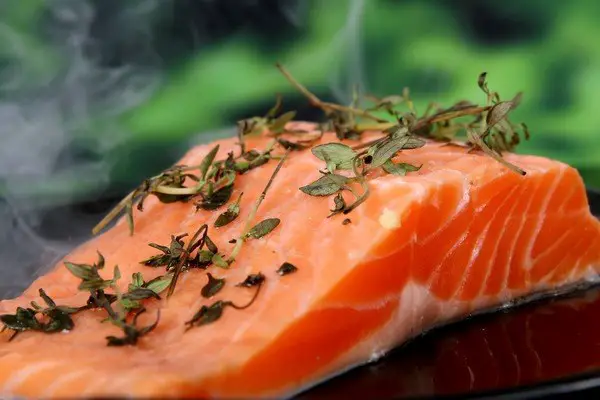 Fatty fish like salmon, herring, and mackerel promote hair growth due to their concentration of omega-3 fatty acids. A study including 120 women who took a fish oil supplement plus antioxidants found that their hair, on average, was denser and that they lost less of it. Another study concluded that fish oil supplements can significantly reduce hair loss in women with thinning hair. If you are not a fan of fish, a fish oil supplement is an excellent alternative. However, fish also contains other hair-healthy nutrients, including protein, selenium, vitamin D3, and B vitamins.
Fatty fish like salmon, herring, and mackerel promote hair growth due to their concentration of omega-3 fatty acids. A study including 120 women who took a fish oil supplement plus antioxidants found that their hair, on average, was denser and that they lost less of it. Another study concluded that fish oil supplements can significantly reduce hair loss in women with thinning hair. If you are not a fan of fish, a fish oil supplement is an excellent alternative. However, fish also contains other hair-healthy nutrients, including protein, selenium, vitamin D3, and B vitamins. Sweet potatoes make the list because of their beta-carotene. This compound is converted by the body into vitamin A, which we know helps in the production of sebum. Sebum is critical to scalp health and by extension, helps keep hair moisturized. Vitamin A may also increase the rate of hair growth and encourage thicker strands, as well as prevent other hair follicles from regressing. You can get more than 4x your RDA of beta carotene in one medium sweet potato.
Sweet potatoes make the list because of their beta-carotene. This compound is converted by the body into vitamin A, which we know helps in the production of sebum. Sebum is critical to scalp health and by extension, helps keep hair moisturized. Vitamin A may also increase the rate of hair growth and encourage thicker strands, as well as prevent other hair follicles from regressing. You can get more than 4x your RDA of beta carotene in one medium sweet potato.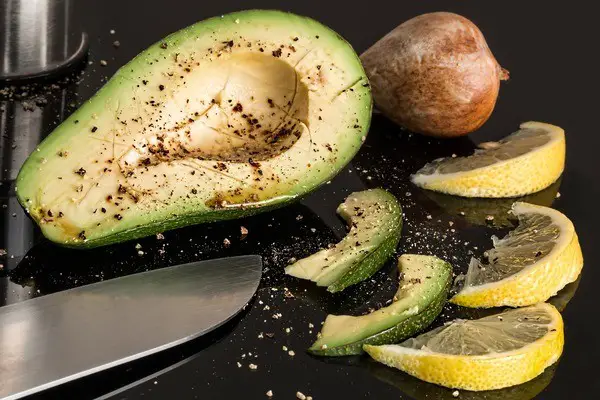 Avocados contain healthy fats along with a nice amount of vitamin E, plus they are just yummy. Like vitamin C, vitamin E is an antioxidant that is great at neutralizing harmful free radicals and promoting hair growth. One study of people with hair loss found that participants experienced 34.5% more hair growth after eight months of taking a vitamin E supplement. E also plays a strong role in protecting the scalp from oxidative stress and damage, and dry or damaged scalp often results in fewer active hair follicles. The essential fatty acids founds in avocados are vital building blocks for your cells, being deficient in EFAs is known to contribute to hair loss.
Avocados contain healthy fats along with a nice amount of vitamin E, plus they are just yummy. Like vitamin C, vitamin E is an antioxidant that is great at neutralizing harmful free radicals and promoting hair growth. One study of people with hair loss found that participants experienced 34.5% more hair growth after eight months of taking a vitamin E supplement. E also plays a strong role in protecting the scalp from oxidative stress and damage, and dry or damaged scalp often results in fewer active hair follicles. The essential fatty acids founds in avocados are vital building blocks for your cells, being deficient in EFAs is known to contribute to hair loss.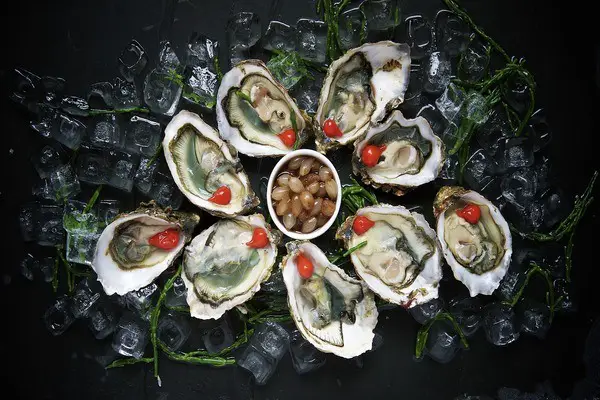 Oysters are kind of an acquired taste, so if you don’t like them, don’t worry. They are great for hair growth because of their zinc content, but zinc can also be found in high amounts in foods like red meat, legumes (chickpeas, lentils, and beans), dairy, eggs, whole wheat, nuts, and seeds. Zinc is a mineral that supports your hair’s growth and repair cycle. A deficiency in zinc has been linked to a form of hair loss called telogen effluvium, which luckily, is reversible by getting more zinc into your diet. Be aware, however, that too much zinc can also cause hair loss. Getting your RDA from food sources is advised, because they provide small but healthy doses, whereas supplements may overload you.
Oysters are kind of an acquired taste, so if you don’t like them, don’t worry. They are great for hair growth because of their zinc content, but zinc can also be found in high amounts in foods like red meat, legumes (chickpeas, lentils, and beans), dairy, eggs, whole wheat, nuts, and seeds. Zinc is a mineral that supports your hair’s growth and repair cycle. A deficiency in zinc has been linked to a form of hair loss called telogen effluvium, which luckily, is reversible by getting more zinc into your diet. Be aware, however, that too much zinc can also cause hair loss. Getting your RDA from food sources is advised, because they provide small but healthy doses, whereas supplements may overload you. Shrimp is a great all-around food for healthy hair because it contains protein, B vitamins, zinc, iron, and vitamin D, all of which may promote strong locks. Shrimp also contains a small amount of omega-3 fatty acids, despite being very low fat in general. EFAs are linked to improved hair growth, while a deficiency in vitamin D3 seems to contribute to hair loss. You may also want to speak to your doctor about taking a D supplement – because this is a nutrient primarily synthesized in response to sun exposure, more and more adults are being found deficient because we spend so much time inside.
Shrimp is a great all-around food for healthy hair because it contains protein, B vitamins, zinc, iron, and vitamin D, all of which may promote strong locks. Shrimp also contains a small amount of omega-3 fatty acids, despite being very low fat in general. EFAs are linked to improved hair growth, while a deficiency in vitamin D3 seems to contribute to hair loss. You may also want to speak to your doctor about taking a D supplement – because this is a nutrient primarily synthesized in response to sun exposure, more and more adults are being found deficient because we spend so much time inside. If you’re looking to cut back on meat but don’t want to neglect your protein intake, beans are a perfect solution. But beyond a nice amount of protein, beans deliver iron, biotin, zinc, and folate, all of which are essential for healthy hair growth. Even better, beans are very versatile and quite affordable, so you can eat a lot of them. If you are struggling with hair loss that is not genetic or hormonal in nature (such as post pregnancy or male pattern baldness), or if your hair grows much more slowly than average (0.5 inches per month or 6 inches per year), diet may be part of the cause. Focus on eating foods that are high in protein, vitamins A, C, D, and E, essential fatty acids, and iron. Zinc, folate, and biotin are also linked to healthy hair growth. A well-rounded diet cures a multitude of ills, and a thick, lustrous head of hair is just one indication that you are healthy inside and out.
If you’re looking to cut back on meat but don’t want to neglect your protein intake, beans are a perfect solution. But beyond a nice amount of protein, beans deliver iron, biotin, zinc, and folate, all of which are essential for healthy hair growth. Even better, beans are very versatile and quite affordable, so you can eat a lot of them. If you are struggling with hair loss that is not genetic or hormonal in nature (such as post pregnancy or male pattern baldness), or if your hair grows much more slowly than average (0.5 inches per month or 6 inches per year), diet may be part of the cause. Focus on eating foods that are high in protein, vitamins A, C, D, and E, essential fatty acids, and iron. Zinc, folate, and biotin are also linked to healthy hair growth. A well-rounded diet cures a multitude of ills, and a thick, lustrous head of hair is just one indication that you are healthy inside and out. 




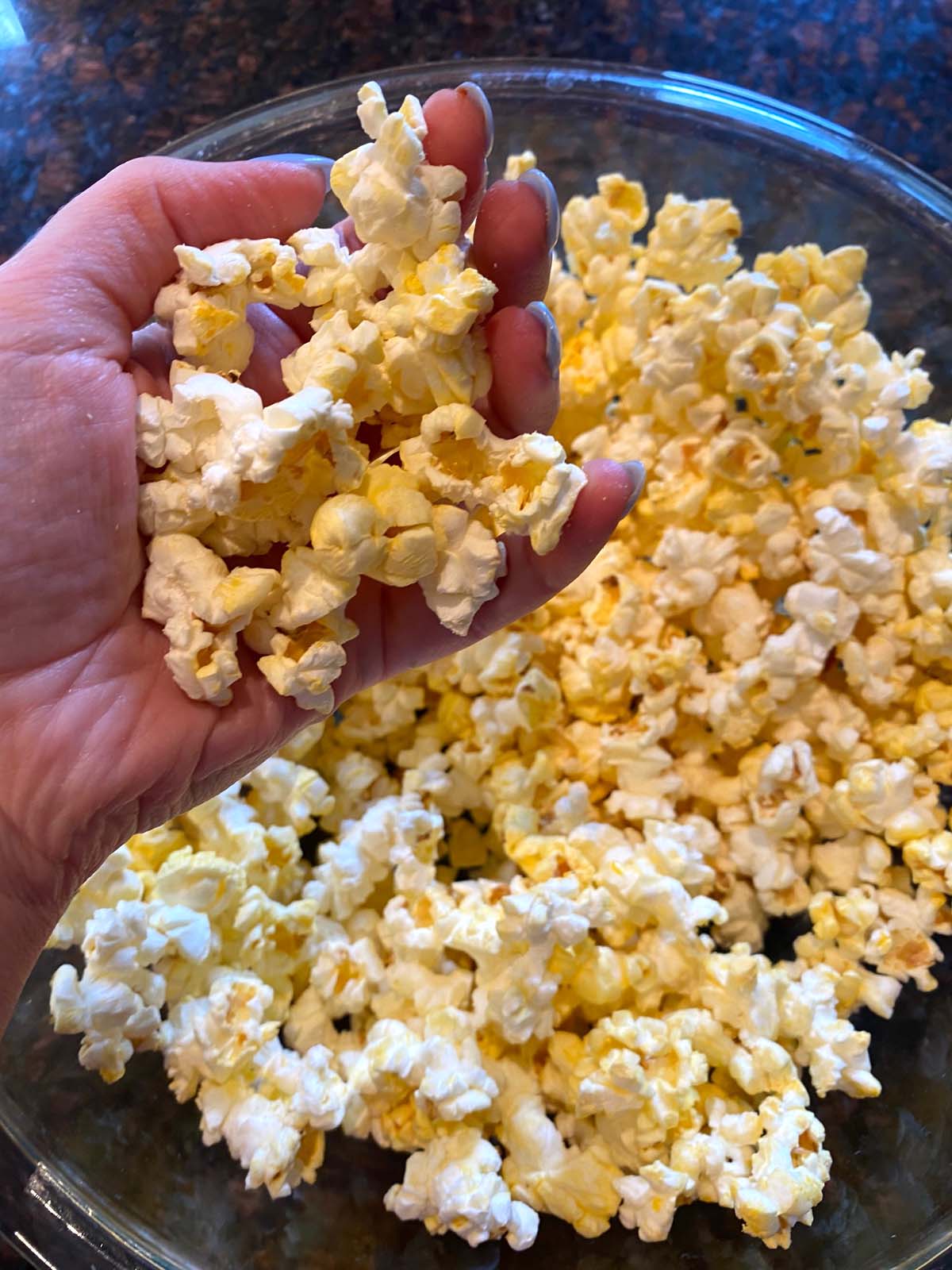 Sure it’s easy to pop a bag of popcorn in the microwave when you want a quick and tasty snack, but is it really worth risking yourself for liver, testicular and pancreatic cancer? The microwave popcorn bags you have in your cabinet are lined with carcinogenic chemicals AND so is a chemical in the popcorn itself, which creates the artificial butter flavor. If you can’t give up your favorite movie-time snack, it’s time to switch to the old-fashioned stove top or a kernel popping machine like you see at movie theaters.
Sure it’s easy to pop a bag of popcorn in the microwave when you want a quick and tasty snack, but is it really worth risking yourself for liver, testicular and pancreatic cancer? The microwave popcorn bags you have in your cabinet are lined with carcinogenic chemicals AND so is a chemical in the popcorn itself, which creates the artificial butter flavor. If you can’t give up your favorite movie-time snack, it’s time to switch to the old-fashioned stove top or a kernel popping machine like you see at movie theaters.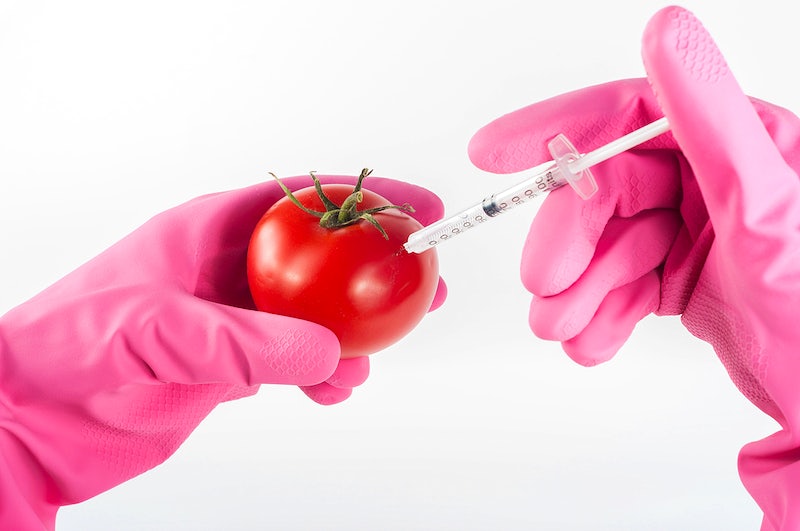
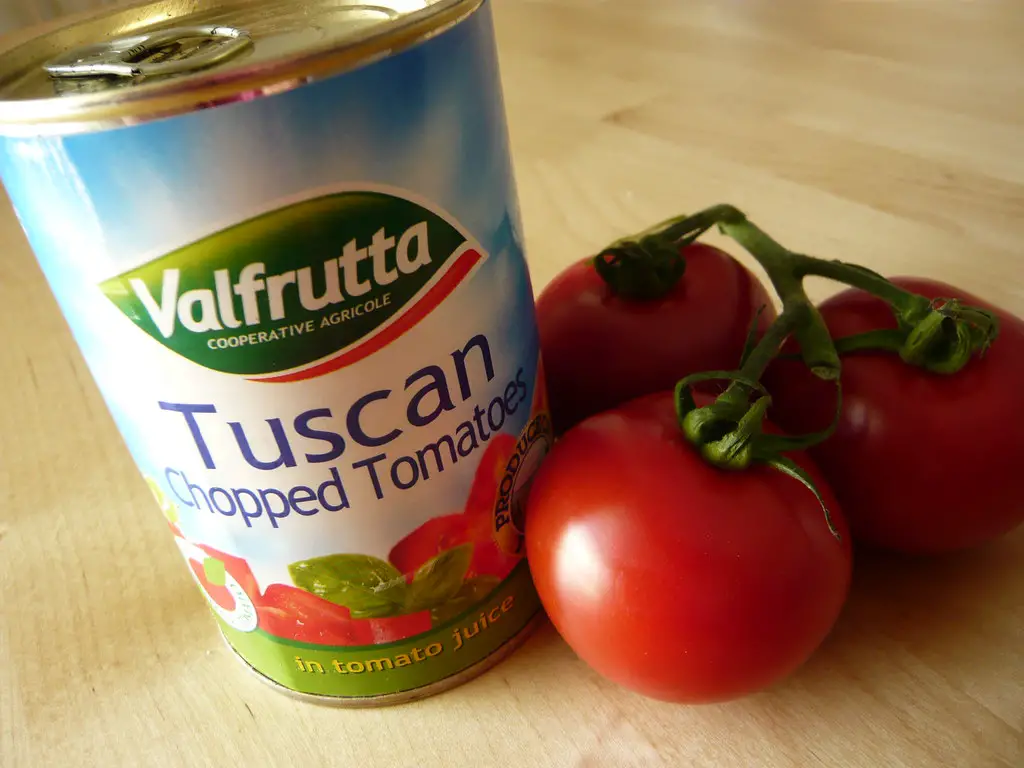 I know what you’re thinking… You’ve likely heard how the nutrient Lycopene in tomatoes lowers cancer risks, but that benefit is completely cancelled out when the lining of canned tomatoes contain chemicals that disrupt hormonal activity in the body. Since tomatoes are so acidic, the chemical BPA actually leeches from the lining into the tomatoes. This toxic chemical has been linked to different cancers, heart disease and reproductive problems. Next time you feel like making a nice red sauce, go with a glass jar or stew the tomatoes yourself.
I know what you’re thinking… You’ve likely heard how the nutrient Lycopene in tomatoes lowers cancer risks, but that benefit is completely cancelled out when the lining of canned tomatoes contain chemicals that disrupt hormonal activity in the body. Since tomatoes are so acidic, the chemical BPA actually leeches from the lining into the tomatoes. This toxic chemical has been linked to different cancers, heart disease and reproductive problems. Next time you feel like making a nice red sauce, go with a glass jar or stew the tomatoes yourself.
 Sure fish, especially salmon, is known as one of the healthiest foods out there, but unfortunately more than 60% of salmon in the U.S. is farm-raised… and could be deadly. Farm-raised fish are fed unnatural diets and contaminated with chemicals, antibiotics, pesticides and other known carcinogens found in materials like asbestos. Farmed salmon is also fattier than fresh salmon, which means it soaks up more toxins. Next time you want a healthy omega-3 packed, treat yourself to fresh Alaskan salmon instead.
Sure fish, especially salmon, is known as one of the healthiest foods out there, but unfortunately more than 60% of salmon in the U.S. is farm-raised… and could be deadly. Farm-raised fish are fed unnatural diets and contaminated with chemicals, antibiotics, pesticides and other known carcinogens found in materials like asbestos. Farmed salmon is also fattier than fresh salmon, which means it soaks up more toxins. Next time you want a healthy omega-3 packed, treat yourself to fresh Alaskan salmon instead.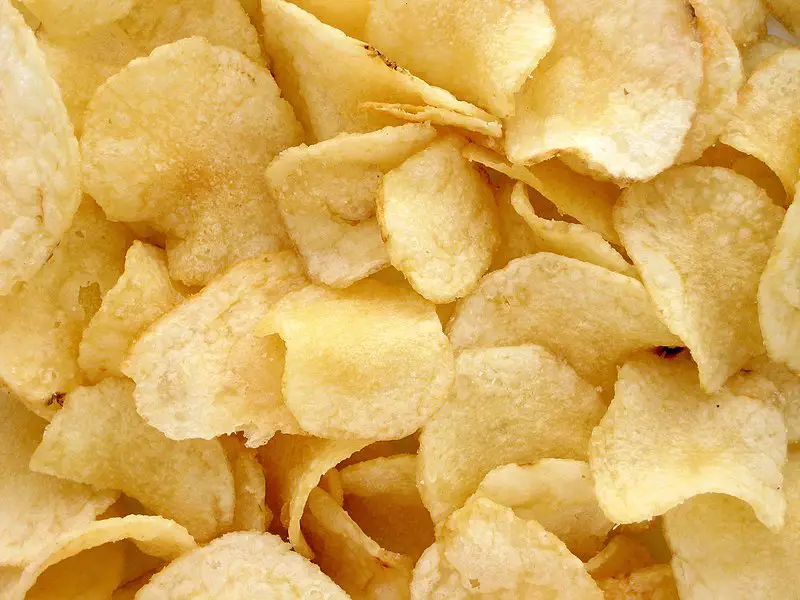 They may be cheap, easy and delicious, but these crispy, addicting snacks can also be deadly. These fatty foods don’t only cause weight gain because of their high trans-fat content, they also have excessive sodium levels, which cause high blood pressure and artificial flavors, preservatives and colors. Another risk is the presence of acrymalide, a known carcinogen found in cigarettes. Try not to feed these quick snacks to yourself or your kids and choose pretzels, air-popped popcorn or baked apple chips instead.
They may be cheap, easy and delicious, but these crispy, addicting snacks can also be deadly. These fatty foods don’t only cause weight gain because of their high trans-fat content, they also have excessive sodium levels, which cause high blood pressure and artificial flavors, preservatives and colors. Another risk is the presence of acrymalide, a known carcinogen found in cigarettes. Try not to feed these quick snacks to yourself or your kids and choose pretzels, air-popped popcorn or baked apple chips instead.
 They may be delicious, but many salty, pickled and smoked foods are processed with the preservative nitrate, which changes in our bodies to N-nitroso composites, which are associate with high cancer-developing risks. Smoked foods like meat or nuts absorb the smoke, which contains the same tar found in cigarettes. Colorectal and stomach cancer are linked to salty, pickled and smoked foods. Do you have a taste for these cravable foods now?!
They may be delicious, but many salty, pickled and smoked foods are processed with the preservative nitrate, which changes in our bodies to N-nitroso composites, which are associate with high cancer-developing risks. Smoked foods like meat or nuts absorb the smoke, which contains the same tar found in cigarettes. Colorectal and stomach cancer are linked to salty, pickled and smoked foods. Do you have a taste for these cravable foods now?! Oprah famously lost a lot of weight by cutting out anything white, especially the big culprit – white flour. You may have heard it’s bad for you, but you probably don’t realize that chemically-bleaching flour with chlorine gas kills all of it’s healthy nutrients. Chlorine gas can be deadly when inhaled, so why would we want it in our dinner? White flour also contains a high glycemic rate, which raises blood sugar and insulin levels and can directly cause diabetes. Cancerous tumors feed on sugar in the bloodstream, so by avoiding refined grains like processed white flour, you can avoid or starve deadly tumors.
Oprah famously lost a lot of weight by cutting out anything white, especially the big culprit – white flour. You may have heard it’s bad for you, but you probably don’t realize that chemically-bleaching flour with chlorine gas kills all of it’s healthy nutrients. Chlorine gas can be deadly when inhaled, so why would we want it in our dinner? White flour also contains a high glycemic rate, which raises blood sugar and insulin levels and can directly cause diabetes. Cancerous tumors feed on sugar in the bloodstream, so by avoiding refined grains like processed white flour, you can avoid or starve deadly tumors.
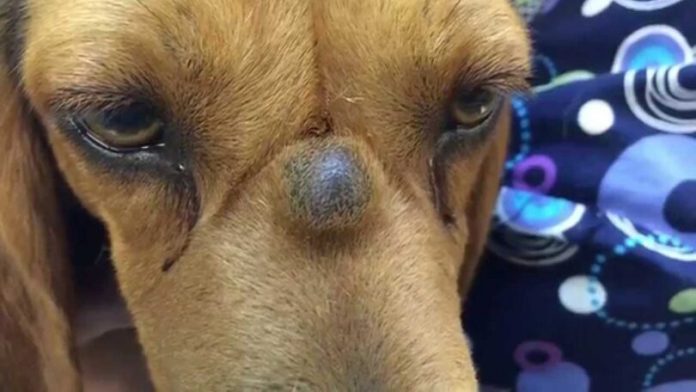
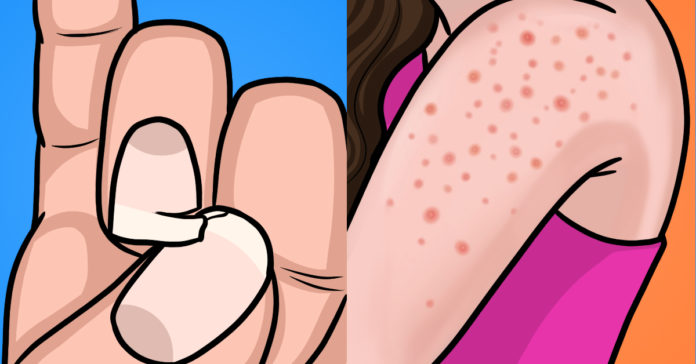
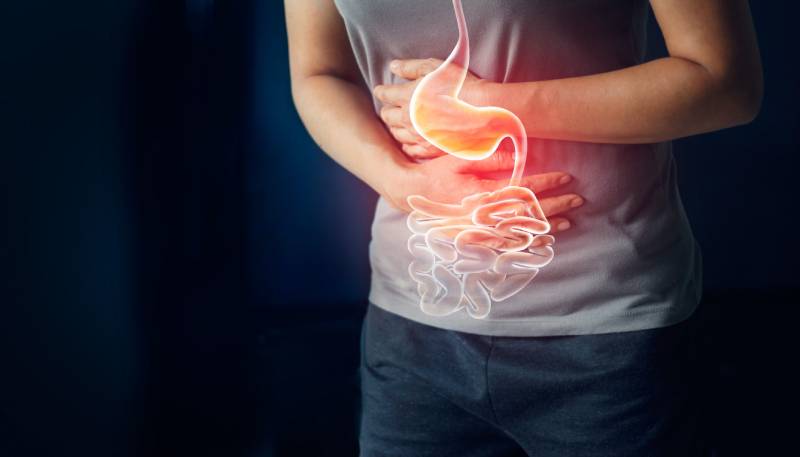 The symptoms are mainly associated with the intestines: nausea, bloating, diarrhea, abdominal pain and even constipation. People often associate these symptoms with other diseases. And patients are misdiagnosed as irritable bowel syndrome (IBS). Studies confirm that 10 to 15% of the world’s population suffers from IBS. But this diagnosis can lead gluten-sensitive people to not receive adequate treatment so that symptoms do not go away.
The symptoms are mainly associated with the intestines: nausea, bloating, diarrhea, abdominal pain and even constipation. People often associate these symptoms with other diseases. And patients are misdiagnosed as irritable bowel syndrome (IBS). Studies confirm that 10 to 15% of the world’s population suffers from IBS. But this diagnosis can lead gluten-sensitive people to not receive adequate treatment so that symptoms do not go away.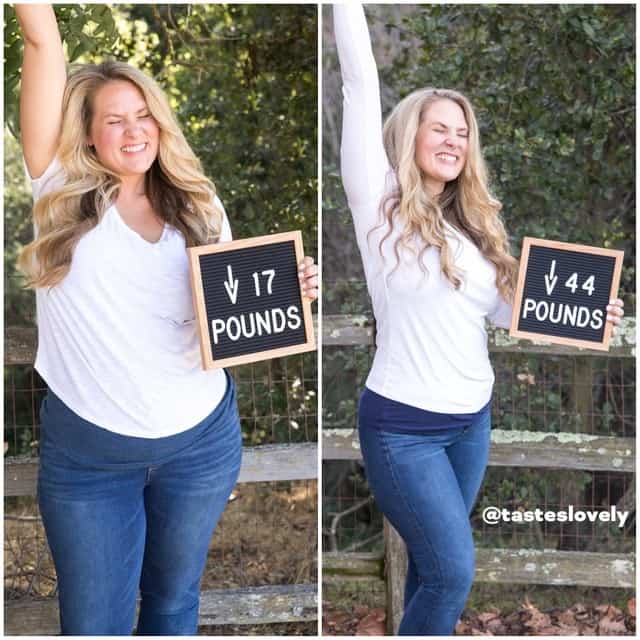 Gluten intolerance can lead to weight loss and weight gain for no apparent reason. This occurs because of inflammatory processes at the cellular level and metabolic disorders. A sudden change in weight can accompany other unpleasant diseases. However, gluten intolerance may be related to other symptoms of malabsorption.
Gluten intolerance can lead to weight loss and weight gain for no apparent reason. This occurs because of inflammatory processes at the cellular level and metabolic disorders. A sudden change in weight can accompany other unpleasant diseases. However, gluten intolerance may be related to other symptoms of malabsorption. There is a direct relationship between gluten intolerance and hormonal disorders that can occur as an irregular menstrual cycle, sudden fluctuations in weight, premenstrual syndrome and sleep disorders. Hormonal failures caused by gluten intolerance can be amplified several times during puberty, pregnancy, and menopause. Keep in mind that these symptoms are mostly recognized by women.
There is a direct relationship between gluten intolerance and hormonal disorders that can occur as an irregular menstrual cycle, sudden fluctuations in weight, premenstrual syndrome and sleep disorders. Hormonal failures caused by gluten intolerance can be amplified several times during puberty, pregnancy, and menopause. Keep in mind that these symptoms are mostly recognized by women.




